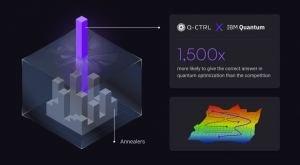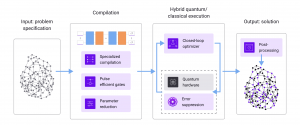
Q-CTRL Transforms Quantum Advantage Outlook, Breaking Records for Optimization Problems & Outperforming Competitive Tech
Groundbreaking results tackle complex problems over 4X larger than the previous record using IBM quantum computers & significantly outperform previous benchmark
LONDON, UNITED KINGDOM, June 5, 2024 /EINPresswire.com/ -- Q-CTRL, a pioneer of quantum infrastructure software to make quantum technologies useful, today announced newly published results that demonstrate a boost of more than 4X in the size of an optimization problem that can be accurately solved, shown for the first time on a cloud-based, utility-scale IBM quantum computer and outperforming competitive annealer and trapped ion technologies. The recent results solidify Q-CTRL’s position at the forefront of the industry and reset expectations for when and how quantum advantage may arrive.
Quantum optimization is one of the most promising quantum computing applications with the potential to deliver major enhancements to critical problems in transport, logistics, machine learning, and financial fraud detection. McKinsey suggests that quantum applications in logistics alone are worth over $200-500B/y by 2035 – if the quantum sector can successfully solve them.
Previous third-party benchmark quantum optimization experiments have indicated that, despite their promise, gate-based quantum computers have struggled to live up to their potential because of hardware errors. In previous tests of optimization algorithms, the outputs of the gate-based quantum computers were little different than random outputs or provided modest benefits under limited circumstances.
As a result, an alternative architecture known as a quantum annealer was believed – and shown in experiments – to be the preferred choice for exploring industrially relevant optimization problems. Today’s quantum computers were thought to be far away from being able to solve quantum optimization problems that matter to industry.
Q-CTRL’s recent results upend this broadly accepted industry narrative by addressing the error challenge. Their methods combine innovations in the problem’s hardware execution with the company’s performance-management infrastructure software run on IBM’s utility-scale quantum computers. This combination delivered improved performance previously limited by errors with no changes to the hardware.
Direct tests showed that using Q-CTRL’s novel technology, a quantum optimization problem run on a 127-qubit IBM quantum computer was up to 1,500 times more likely than an annealer to return the correct result.
Q-CTRL’s groundbreaking results on IBM’s hardware enable quantum optimization algorithms to more consistently find the correct solution to a range of challenging optimization problems at larger scales than ever before. The results show that this combination could practically outperform published results from both trapped-ion devices and annealers by large margins for some problems. Not only can users now solve important problems that were previously out of reach, the dramatic boost in the likelihood of finding the correct solution translates directly into cost savings for users as fewer attempts are required to return the correct solution.
“To bring useful quantum computing to the world we need to both solve the problem of building a quantum computer and discover more practical algorithms,” said Jay Gambetta, IBM Fellow and VP of IBM Quantum. “At IBM we are committed to the first, with our development roadmap. For the second, I am excited to see Q-CTRL taking an important step to deliver practical solutions to industry-relevant optimization problems. Their software solution with an improved QAOA algorithm combined with our utility-scale quantum computers shows that quantum advantage for optimization problems is much closer than we originally thought.”
“It has traditionally been difficult for anyone, even specialists, to take full advantage of what’s possible with utility-scale machines,” said Q-CTRL CEO and Founder Prof. Michael J. Biercuk. “These new results reset expectations of what’s achievable with today’s machines, unambiguously demonstrating that we can now correctly solve industrially relevant optimization problems that have previously been out of reach for quantum computers. There’s a new line of sight to potential quantum advantage in quantum optimization, and best of all, this capability is accessible to anyone without the need to be a quantum expert.”
“This result will be welcome news for those seeking early quantum advantage - we’re finally working with a potentially useful number of qubits,” said David Shaw, Chief Quantum Analyst at Global Quantum Intelligence. “We can expect IBM and others to push further on underlying hardware fidelity, but crucially midstack infrastructure software is also making a bigger than expected contribution for algorithm-specific error suppression and mitigation.”
“Performance management tools like those provided by Q-CTRL on IBM hardware are essential to hardware, algorithm, and application developers to address the noise challenge collaboratively and unlock the potential of quantum computing,” said Julian van Velzen, CTIO & Head of Capgemini's Quantum Lab. “As demonstrated by this work, effectively utilising such tools can elevate the performance of the hardware to a whole new level and bring a potential quantum advantage years closer.”
The achievements are detailed in the technical paper published ahead of The Economist’s Commercialising Quantum Global event on June 5th and 6th, 2024, where these breakthroughs will be showcased publicly for the first time. Any user can get started with Q-CTRL’s performance-enhancement software and an account on IBM Quantum’s cloud platform to validate the results and achieve true value at utility scale.
Event participation
Jay Gambetta will deliver a keynote on June 6th at 9:30 a.m. titled "Harnessing utility for quantum advantage”
Michael J. Biercuk will present a track talk on "All is not lost”: imagining a world without GPS: could quantum fill the void?" on June 6th at 2:30 p.m. on the Main Stage.
About Q-CTRL
Q-CTRL’s quantum control infrastructure software for R&D professionals and quantum computing end users delivers the highest performance error-correcting and suppressing techniques globally and provides a unique capability accelerating the pathway to the first useful quantum computers and quantum sensors. Q-CTRL operates a globally leading quantum sensing division focused on software-level innovation for strategic capability. Q-CTRL also has developed Black Opal, an edtech platform that enables users to quickly learn quantum computing.
Founded by Michael J. Biercuk in 2017, Q-CTRL has pioneered the quantum infrastructure software segment and has become the leading product-focused software company in the broader quantum sector. Q-CTRL has been an inaugural member of the IBM Quantum Network startup program since 2018, and its performance management software now runs natively on IBM quantum computers. The company has international headquarters in Sydney, Los Angeles, Berlin, and Oxford.
Luke Keding
HKA Marketing Communications
+1 315-575-4491
email us here
EIN Presswire does not exercise editorial control over third-party content provided, uploaded, published, or distributed by users of EIN Presswire. We are a distributor, not a publisher, of 3rd party content. Such content may contain the views, opinions, statements, offers, and other material of the respective users, suppliers, participants, or authors.




